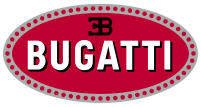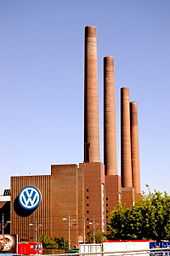Bugatti Automobiles
Coordinates: 48°31′36″N 7°29′59″E / 48.52675556°N 7.499683333°E
 | |
| Type | Private |
|---|---|
| Industry |
|
| Fate | purchased by Volkswagen AG (July, 1998)[1] |
| Predecessor(s) | Automobiles Ettore Bugatti[1] |
| Founded | July 1998[1] |
| Headquarters | Molsheim, France[2] |
| Area served | Worldwide |
| Key people | Wolfgang Dürheimer (President)[2] |
| Products | Veyron 16.4[3] |
| Production output |
|
| Employees | 73[4] |
| Parent | Volkswagen AG[4] |
| Subsidiaries |
|
| Website | bugatti.com |
Bugatti Automobiles S.A.S. is a high-performance luxury automobiles manufacturer; a subsidiary of German Volkswagen AG. Headquartered and assembly planted in Molsheim, Alsace. Volkswagen purchased the Bugatti trademark in June 1998 and incorporated Bugatti Automobiles S.A.S. in 1999.
Bugatti presented several concept cars between 1998 and 2000 before commencing development of its first production model, the Veyron 16.4, delivering the first Veyron to a customer in 2005. The company is currently developing its next production car model, the 16C Galibier, which is expected to go on sale in 2015.
History
At the urging of then-chairman Ferdinand Piëch, Volkswagen purchased the rights to produce cars under the Bugatti marque in June, 1998. This followed the earlier Volkswagen purchases of the Lamborghini marque (by VW's Audi subsidiary), the Rolls-Royce factory in Crewe, United Kingdom, and the Bentley marque.
On 22 December 2000, Volkswagen officially incorporated Bugatti Automobiles S.A.S., with former VW drivetrain chief Karl-Heinz Neumann as president. The company purchased the 1856 Château Saint Jean, formerly Ettore Bugatti's guest house in Dorlisheim, near Molsheim, and began refurbishing it to serve as the company's headquarters. The original factory was still in the hands of Snecma, who were unwilling to part with it. At the Pebble Beach Concours d'Elegance in August 2000, VW announced that they would instead build a new modern atelier (factory) next to and south of the Château. The atelier was officially inaugurated on 3 September 2005.
Bugatti Automobiles S.A.S. is a wholly owned subsidiary of the Volkswagen AG [4]
Early concept cars
ItalDesign Giugiaro designs
Volkswagen commissioned ItalDesign's Giorgetto Giugiaro to design a series of concept cars to return the marque to prominence. The first example, the EB 118, was a two-door coupé and was introduced at the Paris Motor Show in 1998. It was followed by the four-door EB 218 touring sedan, introduced at the Geneva Motor Show in 1999. Later that year, the 18/3 Chiron was shown at the IAA in Frankfurt.
Volkswagen designs
Volkswagen designed the final Bugatti concept, the EB 18/4 GT in house. Bugatti introduced the EB 18/4 at the 1999 Tokyo Motor Show.
W18 Engine
All of these early concepts featured a 555 PS (408 kW; 547 hp) 18-cylinder engine. This was the first-ever W-configuration engine on a passenger vehicle, with three blocks of 6 cylinders each. It shared many components with Volkswagen's modular engine family.
Production cars
Veyron 16.4
Development of this vehicle began with the 1999 EB 18/4 "Veyron" concept car, which itself had a chassis based on that of the Bugatti 18/3 Chiron concept car. It was similar in design and appearance to the final Veyron production car. One major difference was the EB 18/4's use of a W18 engine with three banks of six cylinders. The Veyron's chief designer was Hartmut Warkuss, and the exterior was designed by Jozef Kabaň of Volkswagen, rather than Giorgetto Giugiaro of ItalDesign, who had handled the three prior Bugatti concepts.
The then – Volkswagen Group chairman Ferdinand Piëch announced the Veyron at the 2000 Geneva Motor Show. It was promised to be the fastest, most powerful and most expensive car in history. Instead of the W18, it would use a VR6/WR8-style W16 engine. First seen in the 1999 Bentley Hunaudières concept car, the W16 would have four turbochargers and produce a quoted (metric) 1001 horsepower (see engine section for details on the power output). Top speed was promised at 407 km/h (253 mph), and the price was announced at €1 million.
Development continued throughout 2001 and the EB 16/4 Veyron was promoted to "advanced concept" status. In late 2001, Bugatti announced that the car, officially called the "Bugatti Veyron 16.4", would go into production in 2003. Taking great pride in the making of the Veyron, the production plant (where cars are also ordered) is affectionately called the "Atelier" (artists’ workroom).
Piëch retired that year as chairman of the Volkswagen Group and was replaced by Bernd Pischetsrieder. The new chairman promptly sent the Veyron back to the drawing board for major revisions. Neumann was replaced as Bugatti president by Thomas Bscher in December 2003, and substantial modifications were made to the Veyron under the guidance of a former VW engineer, Bugatti Engineering chief Wolfgang Schreiber.
The Veyron costs €1,100,000 (net price without taxes);[citation needed] prices vary by exchange rates and local taxes (like value added taxes). Prices for the UK or the US are over £880,000, or around $1,400,000. It was noted in an April issue of Live magazine (weekly men's magazine with The Sunday Times) that customers are free to order additional extras which can push the price up by the cost of a Rolls Royce Phantom. During an episode of Top Gear, the car was compared to the Concorde as a feat of technology.[5]
16C Galibier
The 16C Galibier was first unveiled during the Celebration of the Centenary of the Marque in Molsheim. The presentation was only for Bugatti customers. The car show in Molsheim showed the car in blue carbon fibre and aluminum parts. One year later Bugatti showed the world the 16C Galibier Concept at "VW Group Night" at the Geneva Auto Show in a new black and aluminum color combination.
The Galibier, a 1000 HP sedan, was first shown as a concept in 2010 and when they planned to put it into production in 2015, It would have cost about $1.4 million. It would use the same 16-cylinder 8.0-litre engine as the Veyron but instead of four turbos, the 16C Galibier would instead use two superchargers to deliver better torque. Production would require new facilities in Molsheim, France, to be refitted, which pushed back potential deliveries until 2015.[6]
Citations
References
- "Volkswagen Aktiengesellschaft Facts and Figures 2012" (PDF). volkswagenag.com. Volkswagen Aktiengesellschaft. 2012-06-11. 1058.809.453.20. Archived from the original on 2012-08-10. Retrieved 2012-08-10.
- Cremer, Andreas (2011-03-31). "Bugatti Said to Get Backing for $1.4 Million Galibier Supercar". Bloomberg Business Week (New York City, New York: BLOOMBERG L.P). ISSN 0007-7135. Archived from the original on 2012-08-11. Retrieved 2012-08-11.
- "BBC Two - Top Gear, Series 7, Episode 5". BBC. 2005-12-11. Retrieved 2013-05-28.
External links
| Bugatti, a brand of the Volkswagen Group since 1998, road car timeline, 1910–present | |||||||||||||||||||||||||||||||||||||||||||||||||||||||||||||||||||||||||||||||||
|---|---|---|---|---|---|---|---|---|---|---|---|---|---|---|---|---|---|---|---|---|---|---|---|---|---|---|---|---|---|---|---|---|---|---|---|---|---|---|---|---|---|---|---|---|---|---|---|---|---|---|---|---|---|---|---|---|---|---|---|---|---|---|---|---|---|---|---|---|---|---|---|---|---|---|---|---|---|---|---|---|---|
| Type | 1910s | 1920s | 1930s | 1940s | 1950s | 1960s | 1963–86 | 1980s | 1990s | 2000s | 2010s | ||||||||||||||||||||||||||||||||||||||||||||||||||||||||||||||||||||||
| 0 | 1 | 2 | 3 | 4 | 5 | 6 | 7 | 8 | 9 | 0 | 1 | 2 | 3 | 4 | 5 | 6 | 7 | 8 | 9 | 0 | 1 | 2 | 3 | 4 | 5 | 6 | 7 | 8 | 9 | 0 | 1 | 2 | 3 | 4 | 5 | 6 | 7 | 8 | 9 | 0 | 1 | 2 | 3 | 4 | 5 | 6 | 7 | 8 | 9 | 0 | 1 | 2 | 7 | 8 | 9 | 0 | 1 | 2 | 3 | 4 | 5 | 6 | 7 | 8 | 9 | 0 | 1 | 2 | 3 | 4 | 5 | 6 | 7 | 8 | 9 | 0 | 1 | 2 | 3 | ||
| Owner | Defunct | ||||||||||||||||||||||||||||||||||||||||||||||||||||||||||||||||||||||||||||||||
| Company name |
Defunct | Automobiles S.A.S. | |||||||||||||||||||||||||||||||||||||||||||||||||||||||||||||||||||||||||||||||
| Touring car |
Type 30 / Type 49 | Type 57 | |||||||||||||||||||||||||||||||||||||||||||||||||||||||||||||||||||||||||||||||
| Type 46 | |||||||||||||||||||||||||||||||||||||||||||||||||||||||||||||||||||||||||||||||||
| Limousine | Type 41 Royale | ||||||||||||||||||||||||||||||||||||||||||||||||||||||||||||||||||||||||||||||||
| Roadster | Type 13 / Brescia Tourer | Type 55 | |||||||||||||||||||||||||||||||||||||||||||||||||||||||||||||||||||||||||||||||
| Coupé | Type 101 | ||||||||||||||||||||||||||||||||||||||||||||||||||||||||||||||||||||||||||||||||
| Sports car |
Type 13 | Type 18 Garros | Type 252 | EB110 | Veyron EB 16.4 | ||||||||||||||||||||||||||||||||||||||||||||||||||||||||||||||||||||||||||||
| Race car | Type 35 | ||||||||||||||||||||||||||||||||||||||||||||||||||||||||||||||||||||||||||||||||
| ||||||||||||||||||||||||||||||||||||||||||||||||
| |||||||||||||||||
%2C_5._April_2012%2C_D%C3%BCsseldorf.jpg)
